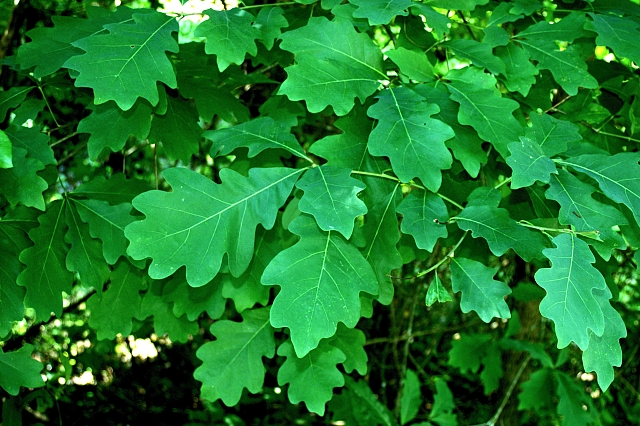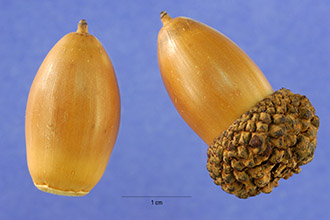Quercus alba
KWER-kusmAL-buh
Linnaeus
White Oak, Stave Oak, Ridge White Oak, Forked-leaf White Oak


"White oak grows in the rich, deep, well-drained acid soils of the east Texas Pineywoods. It is prized as a regal, tall shade tree because of its attractive green summer foliage, red fall color, light, flaky bark, and a classic look that improves with age. White oaks have similar sensitivities to soil compaction and disturbance as Post Oaks (Q. stellata), and they also have a strong tendency to develop symptoms of iron deficiency (chlorosis) on high pH soils. They grow slowly and have a long taproot, making it hard to transplant them from the wild. The acorns are important food for wildlife."
White oak grows throughout much of the eastern United States from southwest Maine to northern Florida, Alabama, and Georgia. It extends westward throughout southern Ontario and Quebec into central Michigan, northern Wisconsin, and southeastern Minnesota and south to southwestern Iowa, eastern Kansas, eastern Oklahoma, and eastern Texas.
We have this species on Prince Edward Island and I (Bill Oehlke) utilize lower branches and sometimes entire smaller trees for sleeve rearing of Antheraea polyphemus.
This deciduous, medium to large tree (height to one hundred plus feet; width from sixty to eighty feet) likes full to patial sun, tolerates medium heat and gets by on a medium amount of moisture.
It prefers acid soils and is hardy to USDA Hardiness Zone: 4.
Simple dark-green alternate leaves are four to eight inches long and have round lobes (five to nine lobes per leaf). Fall colours are brown, red, to wine with brown leaves remaining on tree into the winter. New leaves are a bright greyish green.
Green catkins in appear in clusters in the spring, producing mature acorns in late summer to early fall.Image of acorns courtesy of Steve Hurst @ USDA-NRCS PLANTS Database | 
|
The acorns quickly lose viability if allowed to dry out. They can be stored moist and cool over the winter, but are best sown as soon as ripe in an outdoor seed bed, protected from mice, squirrels etc. Plants produce a deep taproot and need to be planted out into their permanent positions as soon as possible, in fact seed sown in situ will produce the best trees.
The Natural History Museum reports Quercus alba as a host for the following butterfly species:
Erynnis juvenalis
Erora laeta
Fixsenia ontario
Parrhasius m-album
Satyrium calanus
Satyrium edwardsii
The Natural History Museum reports Quercus alba as a host for the following Saturniidae species:
Actias luna
Anisota finlaysoni
Anisota senatoria
Anisota stigma
Anisota virginiensis
Antheraea paphia
Antheraea pernyi
Antheraea polyphemus
Automeris cecrops
Automeris io
Automeris metzli
Automeris zephyria
Eacles imperialis
Hyalophora cecropia
The Natural History Museum reports Quercus alba as a host for the following Sphingidae:
Ceratomia undulosa
The Natural History Museum reports Quercus alba as a host for the following Catocala species:
Catocala aholibah
Catocala amica
Catocala ilia
Catocala robinsonii
Catocala verrilliana
Tree information is from Aggie Horticulture
This page designed and maintained by Bill Oehlke as an extension of the
World's Largest Saturniidae Site, a private worldwide silkmoth site,
Caterpillars Too!, a private North American butterfly site featuring images of caterpillars,
Sphingidae of the Americas, a free public access site with pictures and information about the Sphingidae (Hawkmoths) of the Americas.
North American Catocala, a free public access site with pictures and information about the Catocala (Underwing moths) of Canada and the United States.
Use your browser "Back" button to return to the previous page.